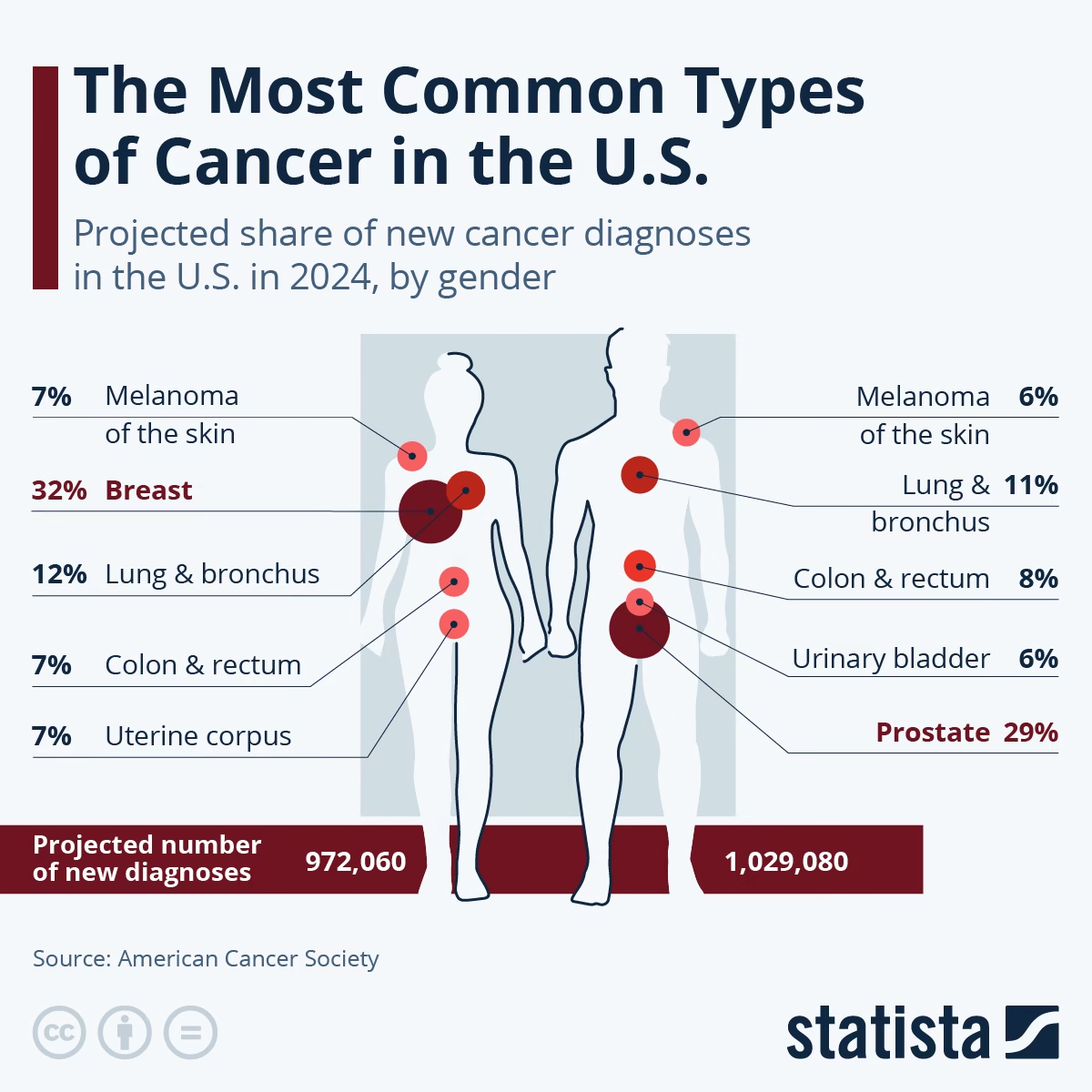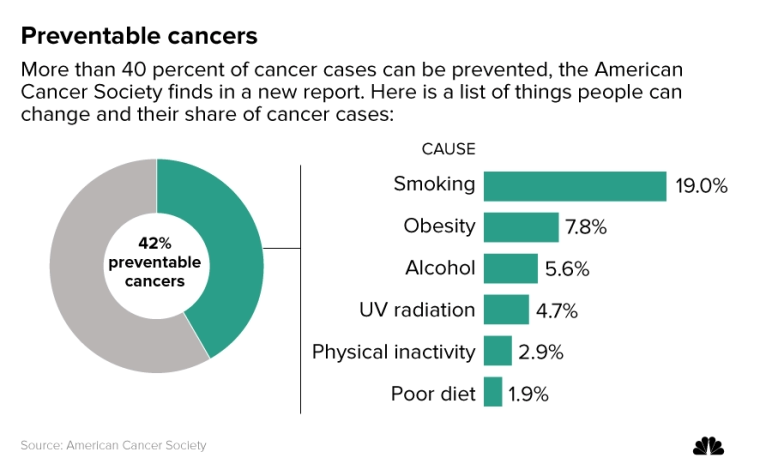
Cancer is a group of diseases characterized by the uncontrolled growth and spread of abnormal cells in the body, which can form tumors or invade tissues and organs. It arises from genetic mutations, often triggered by factors like environmental exposures, lifestyle choices, or inherited predispositions. Cancer can affect nearly any part of the body, with common types including breast, lung, prostate, and colorectal cancers. Image source: Blue Diamond
Read these first:
- Health 101: Dr. Peter Attia: A Secret Journey into Health and Longevity
- Health 101: The Goodness of Pulses – Indian Lentils and Legumes
- Health 101: The Health Benefits and History of Traditional Indian Spices
- Health 101: Understanding Cholesterol: The Good And The Bad
- Health 101: Strategies for Boosting Weak Immune System Naturally
What is Cancer?
Cancer is fundamentally a disease characterized by the uncontrolled growth and proliferation of cells within the body. This abnormal cellular behavior occurs when the mechanisms that normally regulate the cell cycle become disrupted. Healthy cells undergo a carefully controlled process of growth, division, and death. However, in cancerous cells, this regulation fails, leading to an increase in cell division and survival, which can result in tumor formation.
Within the realm of cancer, tumors can be classified into two primary categories: benign and malignant. Benign tumors, while abnormal, generally do not spread to other parts of the body and do not pose a significant threat to health. Conversely, malignant tumors are cancerous; they possess the ability to invade surrounding tissues and can metastasize, or spread, to distant organs through the bloodstream or lymphatic system. This capacity for metastasis is one of the defining features that distinguishes malignant tumors from their benign counterparts and contributes significantly to disease severity.
The progression of cancer is often described in stages, commonly categorized from stage 0 to stage IV. Stage 0 refers to the presence of abnormal cells that may develop into cancer but are localized and thus non-invasive. As the stage progresses, the cancer typically grows in size, becomes invasive, and may spread to nearby lymph nodes or distant parts of the body. The staging of cancer plays a crucial role in determining the prognosis and guiding treatment decisions, with earlier stages generally associated with better outcomes.
Understanding the biological basis of cancer, including the distinction between benign and malignant tumors, the significance of metastasis, and the stages of development, is imperative for both prevention and treatment strategies. This knowledge equips individuals and healthcare professionals alike with the insights necessary to combat this pervasive disease.
Common Types of Cancer
Cancer remains one of the leading health concerns globally, with various types affecting millions of individuals each year. Among these, breast cancer is notably prevalent, particularly among women. This disease manifests when abnormal cells in the breast multiply uncontrollably, leading to potentially severe health complications. Symptoms may include noticeable lumps, changes in breast shape, or discharge from the nipple. The risk factors for breast cancer include age, genetics, and lifestyle choices such as alcohol consumption and obesity.
Another common form is lung cancer, often associated with smoking, though non-smokers can develop this condition too. Symptoms of lung cancer may include a persistent cough, weight loss, and difficulty breathing. Its prevalence is significantly higher in regions with high smoking rates, and men are at greater risk than women. Early detection through screening can improve outcomes, but awareness remains essential for better prevention.
Prostate cancer ranks as the second most common cancer among men. While it often develops slowly, alarming symptoms such as difficulty urinating or blood in urine can indicate advanced stages of the disease. Age and family history are critical demographic risk factors, with Black men facing a notably higher risk. Regular screening is advised for early detection in at-risk groups.
Colorectal cancer affects both men and women, primarily emerging in the rectum or colon. Symptoms can include changes in bowel habits, abdominal discomfort, and unexplained weight loss. Preventive measures include routine screenings, especially for individuals over the age of 45 or those with a family history of the disease.
Lastly, skin cancer, particularly melanoma, is increasingly common among younger populations. It can be identified by changes in moles or abnormal skin growths. Ultraviolet (UV) radiation exposure poses significant risk factors, underscoring the importance of sun safety practices. This cancer type demonstrates that awareness and early intervention can lead to favorable outcomes.

The most frequently diagnosed types of cancer are breast cancer for women and prostate cancer for men. In 2024, almost one-third of all new cancer diagnoses in women will be breast cancer. That number is slightly lower at 29 percent for prostate cancer in men. Men in the U.S. will be diagnosed with lung cancer – the second most common cancer for both sexes – slightly less than women. But they are diagnosed with colorectal cancers more often, which has become the number one cause of cancer-related deaths for men below 50. Chart and text source: Statista
Rare Types of Cancer
Cancer encompasses a diverse array of diseases, and among these, rare types of cancer present unique challenges in terms of diagnosis, treatment, and awareness. Rare cancers, often defined as those affecting fewer than 15 people per 100,000 annually, include conditions such as sarcomas, neuroblastoma, and mesothelioma. Each of these cancers exhibits distinct characteristics and requires specialized knowledge for effective management.
Sarcomas, for instance, arise from connective tissues such as bones, muscles, fat, and cartilage. These tumors can occur at any site in the body and are categorized into several subtypes, including osteosarcoma (bone) and liposarcoma (fat). Due to their rarity, sarcomas can be difficult to diagnose as their symptoms often mimic those of more common types of cancer or benign conditions. Timely diagnosis is crucial, as the need for treatment varies significantly between the different forms of sarcomas.
Another rare cancer is neuroblastoma, primarily affecting infants and young children. This cancer originates in the nerve tissue of the adrenal glands, neck, chest, abdomen, or pelvis. Neuroblastoma accounts for a small percentage of childhood cancers but is among the most common solid tumors in young children. The unpredictable nature of neuroblastoma, combined with its varying outcomes, underscores the necessity for early detection and tailored treatment strategies.
Mesothelioma, though often linked to exposure to asbestos, remains relatively uncommon compared to other cancers. Primarily affecting the lining of the lungs, heart, or abdomen, mesothelioma poses significant challenges in diagnosis and treatment due to its latent onset and associated symptoms, which can easily be mistaken for other conditions. Increased awareness regarding risk factors, particularly occupational exposure, is essential for early intervention.
Recognizing these rare types of cancer is imperative for improving patient outcomes. Enhanced research and awareness initiatives will aid in ensuring that individuals affected by these conditions receive the appropriate care and support they require.
Genetic Factors in Cancer Development
Cancer is a complex disease with multiple underlying causes, one of which is genetics. Genetic factors play a crucial role in the development of various cancer types, as certain inherited mutations can significantly increase an individual’s risk of developing the disease. These mutations often occur in specific genes responsible for regulating cell growth and division. Examples of such genes include BRCA1 and BRCA2, which are frequently associated with breast and ovarian cancer. Individuals with inherited mutations in these genes have a markedly higher risk for these cancers than the general population.
Family history is another critical aspect to consider when evaluating the genetic factors that contribute to cancer risk. If a person has relatives who have been diagnosed with specific cancers, their genetic predisposition to those cancers may be elevated. This is particularly relevant for cancers that are known to cluster in families, such as colorectal and prostate cancer. Understanding one’s family medical history can provide valuable insights into potential risks, enabling early surveillance and preventive measures.
As advancements in genetic testing have emerged, the ability to identify individuals with these mutations has improved significantly. Genetic testing can assess an individual’s risk and help guide decisions regarding preventative care, surveillance, and treatment options. For example, individuals identified as carriers of high-risk mutations may choose to undergo more frequent screening or consider risk-reduction strategies, such as prophylactic surgeries. Thus, understanding genetic factors in cancer development offers critical insights that can lead to preemptive measures and targeted therapies, ultimately enhancing patient outcomes.

Cancer is caused by genetic mutations that disrupt normal cell growth and division, often triggered by a mix of factors. These include environmental exposures like tobacco smoke, UV radiation, and carcinogens (e.g., asbestos or processed meats); lifestyle factors such as poor diet, obesity, or lack of physical activity; infections like HPV or hepatitis viruses; and inherited genetic predispositions. Image source: NBC
Environmental and Lifestyle Causes of Cancer
Cancer development is influenced significantly by a myriad of environmental and lifestyle factors. Understanding these elements is crucial for establishing preventive measures. One of the most significant contributors to cancer risk is tobacco use. Smoking has been unequivocally linked to various cancers, most notably lung cancer. The harmful chemicals found in tobacco smoke can lead to mutations in the DNA of lung cells, resulting in uncontrolled cellular growth.
Another critical factor is diet. Diets high in processed foods and red meats have been associated with an increased risk of cancers such as colorectal cancer. Conversely, diets rich in fruits, vegetables, and whole grains provide essential nutrients and antioxidants which may help protect against cancer. It is vital to recognize that maintaining a balanced and healthy diet encompasses a proactive approach toward cancer prevention.
Exposure to environmental toxins also plays a role in cancer risk. Certain chemicals found in the workplace or air pollutants can increase the likelihood of various cancers. For instance, prolonged exposure to asbestos is linked to mesothelioma, while benzene exposure has been associated with leukemia. Furthermore, living in areas with high levels of air pollution can contribute to overall cancer risk, culminating in significant public health concerns.
UV radiation is another environmental risk factor, primarily from sunlight. Excessive exposure to ultraviolet rays can lead to skin cancers, including melanoma. Preventative measures such as using sunscreen and wearing protective clothing are essential in mitigating this risk. Additionally, physical inactivity has been correlated with various types of cancer, including breast, endometrial, and colon cancers. Regular exercise can aid in maintaining a healthy weight and improve overall health, contributing to reduced cancer risk.
In conclusion, a comprehensive understanding of how environmental and lifestyle factors contribute to cancer can empower individuals to make informed choices, fostering healthier lives and potentially reducing cancer risk.
Viral and Bacterial Contributions to Cancer
Cancer, a complex group of diseases characterized by uncontrolled cell growth, has been linked to various etiological factors, including viral and bacterial infections. Certain viruses and bacteria are recognized as significant contributors to cancer development, providing an area of interest in oncology research. Among the viruses associated with cancer, human papillomavirus (HPV) represents a prominent example. HPV is a sexually transmitted virus that can lead to cervical cancer and several other malignancies, including anal, oropharyngeal, and vulvar cancers. The mechanism involves the integration of viral DNA into the host genome, leading to genetic alterations that promote tumorigenesis.
Another noteworthy viral contributor is the hepatitis B virus (HBV) and hepatitis C virus (HCV). Both viruses are primarily associated with liver cancer (hepatocellular carcinoma). Chronic infection with HBV or HCV results in persistent liver inflammation and damage, culminating in cirrhosis and the eventual transformation of liver cells into cancerous cells. HBV can also integrate its DNA into the host’s liver cells, enhancing the disruption of normal cellular processes and facilitating tumor progression.
Bacterial infections also play a critical role in cancer development, with Helicobacter pylori being the most extensively studied example. This bacterium is known for its association with gastric cancer. H. pylori colonizes the stomach lining, leading to chronic inflammation and, in some individuals, gastric ulcers. The chronic inflammatory state is a precursor to changes in gastric tissue, which can lead to malignancy. The intricate interactions between the immune response and H. pylori infection are key to understanding its role in cancer mechanisms.
In summary, the connection between certain viruses and bacteria to cancer development underscores the importance of infectious agents in oncogenesis. Continuous research into these relationships may provide insights for preventive measures and therapeutic strategies in cancer care.
Please accept YouTube cookies to play this video. By accepting you will be accessing content from YouTube, a service provided by an external third party.
If you accept this notice, your choice will be saved and the page will refresh.
.
The Role of Hormones in Cancer
Hormones play a significant role in regulating various bodily functions, including growth, metabolism, and reproduction. However, hormonal imbalances and prolonged exposure to certain hormones can contribute to the development of specific types of cancer, notably breast and prostate cancer. Estrogen and testosterone are two prominent hormones that have been implicated in these cancers, and understanding their influence is vital for grasping cancer risks.
In women, elevated levels of estrogen over extended periods can increase the risk of breast cancer. Estrogen is known to promote the growth of breast tissue, and in some cases, it may also encourage the proliferation of cancerous cells within the breast. Research indicates that prolonged exposure to estrogen, whether through natural production, hormone replacement therapy, or other sources, raises the likelihood of developing breast cancer. This risk is particularly pertinent for postmenopausal women who may use hormone therapy to alleviate menopausal symptoms.
Similarly, in men, testosterone is associated with prostate cancer risk. While testosterone is crucial for male health, an imbalance in its levels can lead to abnormal cellular growth in the prostate. Furthermore, studies suggest that high levels of testosterone may fuel the progression of already existing prostate cancers. This intrinsic link between hormones and cancer highlights the importance of monitoring hormonal health, especially for those in high-risk categories.
The interplay between hormones and cancer risk emphasizes the necessity for individuals to engage in regular health check-ups and discuss hormone therapy options with their healthcare providers. Identifying and addressing hormonal imbalances early can be a proactive measure in mitigating cancer risks. By understanding the role of hormones, patients can make informed decisions regarding hormone therapy and overall health management.
Final Say
Through this exploration of various types of cancer and their underlying causes, it is evident that raising awareness and fostering a thorough understanding of cancer is crucial. The diversity of cancer types—from carcinomas and lymphomas to leukemias—illustrates the complexity of this group of diseases. Each type presents unique challenges and risk factors that necessitate tailored approaches for prevention and treatment. Gaining insight into the genetic, environmental, and lifestyle factors that contribute to cancer development enables individuals to make informed choices regarding their health.
Ongoing research efforts play a pivotal role in enhancing our understanding of cancer biology and improving clinical outcomes. Innovative studies are focused on more effective strategies for cancer prevention, encompassing advances in lifestyle modifications and environmental controls. Researchers are also concentrating on early detection methods, employing technologies such as liquid biopsies and biomarker analysis to catch cancers at their most treatable stages. Additionally, advancements in personalized medicine and immunotherapy are transforming cancer treatment paradigms and providing new hope for patients.
Staying informed about the dynamics of cancer—from its mechanisms to its management—is essential for both medical professionals and the public. Continuous education emphasizes the significance of early detection and fosters a proactive approach to health. Collaborative efforts in research underscore the importance of collective knowledge in combating cancer, facilitating breakthroughs that can lead to improved therapies and better patient outcomes. As we look to the future, the commitment to understanding types of cancer and their causes remains a critical aspect of public health, fostering a society better equipped to face the challenges posed by this disease.